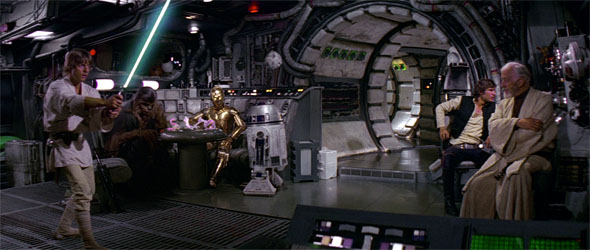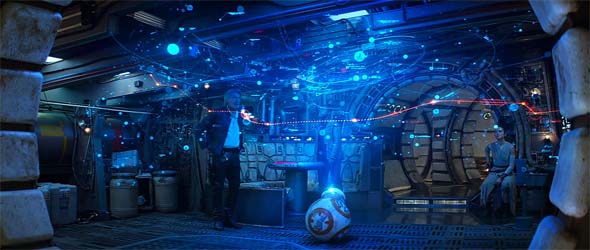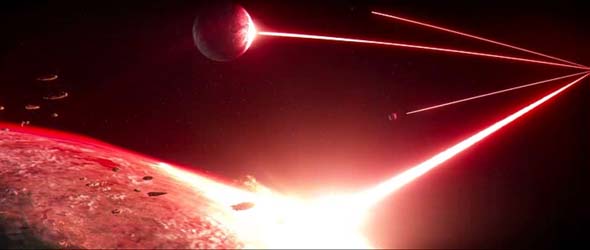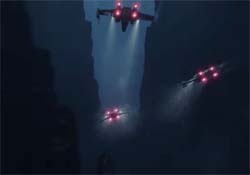In my reviews of The Force Awakens and Rogue One, I complained about how the speed of communications and hyperspace travel seems to have "shrunk" the Star Wars universe. I asserted that the writers seem to have no appreciation for the size and scale of this universe, or for galactic conflict. That observation severely hurt my enjoyment of both films. Star Wars has always flown lose with its science, but even though the original trilogy got a lot of details wrong (ahem, "parsec"!), there at least seemed to be an effort to respect some scientific believability. Even the prequels stayed fairly respectful to the size and scale of the universe and conflict. The new movies, by comparison, seem completely (and deliberately) scientifically illiterate.
Keep in mind that the following analysis is coming from someone with only minimal knowledge of the extended universe. I'm more of a Trekker than a Star Wars fan (a "Warser"?). I have tech manuals of the Enterprise and the star charts of the Federation, but no Star Destroyer tech manuals or Imeprial star charts. So my opinions come from the films alone. Besides, all those novels, video games, and comic books have been de-canonized by Disney anyway. If anyone more knowledgeable of the Star Wars extended universe wants to chip in with corroborating or conflicting information, feel free to do so in the comments. Thanks to Disney's meddling, such knowledge may now be moot.
And oh, by the way, it drives me nuts when Star Trek movies make these sorts of mistakes as well. I'm looking at you, Star Trek V and first episode of Enterprise (among many others)!
Hyperspace originally analogous to contemporary air travel
Let's start by looking at a frame of reference: the trip in the Millenium Falcon in the first Star Wars movie. While the Millennium Falcon is in transit from Tatooine to Alderan, Luke has time to receive some rudimentary Jedi training from Obi Wan, Han calmly relaxes and socializes in the lounge, and Chewbacca has time for at least one game of space-chess against the droids. This hyperspace trip is presented as being analogous to cross-continental (or intercontinental) plane flight: at least enough time for passengers to unfasten their safety belts and wander around the cabin.

A hyperspace trip in the Millennium Falcon offers at least enough time for everyone to lounge about.
But an estimate of hours is on the low end of the spectrum of possibilities. As far as I can tell, there's nothing in the movie that negates the possibility of this trip to Alderaan taking days. That would certainly be plenty of time for Obi Wan to teach Luke enough of the basics of Force-sensitivity to enable his "lucky shot" in the climactic Death Star trench run. It would also give the characters enough time to socialize, converse and develop some sense of camaraderie with one another. It's also enough time for Leia to undergo at least a couple rounds of interrogation aboard the Death Star.
UPDATE January 4, 2017: Influenced by World War II
In addition to possibly being inspired by contemporary intercontinental travel, the Star Wars universe was also heavily influenced by World War II. Imperial uniforms are styled after Nazi German uniforms, and even the all-human Imperial cast may subtly imply a degree of racial purity and cleansing being enforced the Empire. In fact, in early screenings with the studio, many incomplete special effects shots were replaced with footage of dogfights from World War II documentaries. While reading an article ("Countdown to Infamy", written by Steve Twomey) in the December 2016 issue of Smithsonian Magazine, I was reminded of other parallels between the tactics of Star Wars and the tactics of World War II. Specifically, the space battles are heavily inspired by Pacific Theater naval engagements. Time for a little history lesson!
In World War II, the Japanese attack on Pearl Harbor established the aircraft carrier as the ultimate naval weapon - supplanting the battleship that had been the staple of navies since the age of sail. What is a Star Destroyer other than an aircraft carrier in space? Even Han and Luke's turret defense of the Millennium Falcon in the first Star Wars is stylistically reminiscent of the point-defense turrets of a WWII-era heavy bomber.
Space battles and politics in Star Wars are heavily inspired by World War II
By the way, how long did that Japanese fleet take to sail to Pearl Harbor? Well, it took almost two weeks. The fleet had to observe careful radio silence the entire way in order to avoid detection by the United States, and didn't even send out air patrols out of fear that a stray pilot may be detected by American radar or patrols. At the same time, the Japanese battleship fleet loudly sailed towards the Philippines in order to divert the American fleet away from Hawai'i. It was all very meticulously planned and coordinated. Japan had even originally intended for the attack to occur moments after the formal declaration of war being sent to Washington in order to make the sneak attack more honorable. Issues on the mainland prevented the message from being sent on time, but the fleet (out of direct communication with central command) carried out the attack anyway.
Now back to Star Wars...
Space begins to shrink
The original movies leave the time scale of travel somewhat ambiguous through the use of cuts between scenes. This leaves the exact amount of time indeterminate, since we don't see the transit occur in real-time, nor does any dialogue ever provide an explicit time frame. This may have been a deliberate attempt by the writers to leave the capabilities of the technology ambiguous so as not to write themselves into a hole later on.
This trend is consistent throughout all three of the original Star Wars movies: the amount of time (and the exact distances involved) is always left ambiguous. The prequels, to their credit (jeez, I hate having to say that...), also stayed very consistent to this depiction. However, in Force Awakens and Rogue One, we start to see hyperspace travel occurring in real time - and it happens very fast. Even at a rate of days' worth of travel from Tatooine to Alderaan, the hyperdrive of Star Wars is ridiculously fast. A ship going that fast could hypothetically circle the entire galaxy within a matter of weeks or months. Compare this to a ship in Star Trek, which would need a whole century to cross the galaxy at its fastest warp speeds.
In The Force Awakens, however, the rules of travel seem to start to break down. Almost as soon as the Millennium Falcon is commandeered by Rey and Fin, Han's freighter jumps in and tractors it. How far away was Han? We don't know, he never says. He only says that he was searching for the ship's signature, and that anyone else can find the Falcon this way as well. Maybe we can assume that Han was in the near vacinity searching for the ship because he knew roughly where it might be?

A hyperspace trip in The Force Awakens allows enough time to review BB-8's map.
In any case, the Falcon's hyperspace trip allows enough time to perform some repairs and to review BB-8's map. The use of cuts between scenes makes it unclear exactly how much time the ship spends in hyperspace transit, but dialogue later in the movie seems to imply (at least to me) that it wasn't very long (probably a matter of a few minutes to an hour).
This is all fine. So far, so good. Problems start to emerge as the Millennium Falcon makes multiple hyperspace trips from planet to planet (with no idea of how far apart they are), and it all seems to take no time all. The real offense, however, comes as the movie enters its final act, and the Starkiller base destroys the Republic's capital. The Starkiller fires what appears to be a laser, which then proceeds to split into multiple lasers that blow up every planet in an entire star system.

Starkiller Base destroys every planet in an entire star system from somewhere outside that star system.
Where is Starkiller Base respective to these other star systems? If the base is within the same system, then we should expect a laser (which should presumably be bound by the speed of light) to take several minutes (if not hours) to reach its targets. We would also expect the people living on the nearby planets to maybe notice that a whole new planet has appeared in their system, or that one of its existing planets is being hollowed out into a superweapon. If aliens started hollowing out Jupiter, even we -- with our limited technology now -- would almost certainly be able to detect that. However, if Starkiller is in deep space or in a different star system (even a neighboring star system), then it would take literally years for a laser to reach the Republic capital.
It also wouldn't be likely to be possible for planets to be close enough to be seen so clearly from each others' surfaces. J.J. Abrams and his writers did the same thing in Star Trek when they invented a new planet close enough to Vulcan that Spock could watch Vulcan's destruction with his naked eyes. But whatever. These are fictional planets, maybe they are that close (even though established Star Trek cannon said there shouldn't be another planet or moon that close to Vulcan). What's less forgivable is that people on the surface of planets in other star systems could plainly see the laser destroy the Republic capital as it happens.
Characters watching the destruction of planets from another planet's surface is a very unrealistic
dramatic contrivance that J.J. Abrams pulled in both Star Wars and Star Trek.
This was done for dramatic purposes, with no respect for the size and scale of an interstellar setting. Now with Rogue One, the writers have started using the hyperdrive as a narrative crutch to allow instantaneous travel and communication between star systems. At several points in this movie, we now see interstellar communication and transit happening near-instantly, in real-time. There is no ambiguity.
It happens when Cassian crashes his ship on Eadu, the rebels on Yavin immediately recognize that they've lost contact, and they send a squadron of X-Wings that show up mere minutes later to assault the base. It happens again when Rogue One infiltrates the Scarif record-keeping facility and call in a rebel fleet (again from Yavin) to disable the shield and allow them to transmit the Death Star plans. I don't know how far apart these star systems are supposed to be, but the fact that there is no delay at all in communications or travel showed [to me] laziness in the movie's writing.

X-Wing support arrives at Eadu in moments.
Basic elements of the overarching Star Wars storyline just completely break down when travel and communication is instantaneous. The trivialization of hyperspace travel and communication erodes any semblance of a distinction between the tightly-controlled "core" and the supposedly-lawless "outter rim" planets. With travel and communication this fast, there is no logistical limit to the Empire's reach, and there's no concept of a "front line" in the war. There's also no need to hide hard-copies of the Death Star plans if it can be transmitted with no delay across the galaxy. And there's no point in having Darth Vader even bother to pursue or intercept Leia's Blockade Runner if she's going to arrive at her destination in a matter of mere minutes.
This universe has lost the believable, lived-in quality and sense of breadth and variety that the original trilogy so expertly executed. The Star Wars universe - the very space in which it takes place - is now irrevocably broken.
The strategy behind the battle of Endor
We can look at how the trivialization of hyperspace has influenced the military strategy (or the lack thereof) in Rogue One. To do this, let's look at Rogue One's Scarif battle, and compare it to the Battle of Endor in Return of the Jedi (while also keeping in mind the earlier references to the real-life attack on Pearl Harbor). Both Endor and Scarif feature a rebel fleet hyperjumping into an engagement with Imperial forces. But there's important differences between them.
Most notably, the hyperjump in Return of the Jedi doesn't completely ignore distance. This jump happens over the span of just a few minutes of film, but it's still treated with more respect for distance than anything that happens in Rogue One. In Return of the Jedi, the rebels have to take great pains to come up with a plan that requires sending an infiltration team out ahead of the assault fleet in order to disable a shield generator at a designated time. This implies that at least some logistical planning and preparation was necessary in order to make this plan work.
The battles of Endor and Scarif demonstrate the different attitudes the writers had towards hyperdrive limitations.
Return of the Jedi cuts from the main action on Endor's surface, and takes us to Admiral Akbar and Lando preparing the fleet for hyperspace. They get into formation, input the calculations, and make the jump. Then the movie cuts back to the surface of Endor so we can see Han and Leia breaking into the shield generator, then cuts to Luke with the Emperor and Vader on the death star, then back to Han and Leia being captured in the shield generator (thus establishing the Empire's trap, prior to the rebels engaging the Imperial fleet). Then we finally cut to the fleet arriving at Endor space. There's about ten minutes of movie in between, and an indeterminate amount of time within the context of the story.
Even if we assume that the fleet spends only ten minutes in hyperspace (rather than the scene of the fleet jumping to hyperspace having taken place concurrently with the preceeding scene in the Ewok village from the night before), it's entirely possible (and probable) that the fleet met up and organized at a rallying point close to Endor. The trip to that rallying point could have taken much longer. After all, Han, Leia, and Luke are on Endor for at least a whole day while the fleet is either preparing for the battle or is already in-transit. And the movie doesn't give us any indication how long it took for Han, Leia, and Luke to get to Endor to begin with.
The point is that these events are coordinated in advance. The rebels send the infiltration team out ahead of the fleet with the expectation that the shield will be lowered within a certain time span. The action requires careful thought and planning. There's actually strategy involved. The fleet jumps in regardless of whether the shield is down. Han doesn't disable the shield, and then send out a transmission to tell the fleet to jump in, and then the fleet suddenly shows up ad hoc.
But that's exactly what happens in Rogue One. Not only that, but the rebel fleet is diverted from another assignment and sent to Scarif (with no plan, might I add).
Here's a clip from Return of the Jedi to showcase my point.
The fleet meets up at a designated rallying point, and then jumps to Endor at a specified, pre-planned time.
In this scene, Lando's co-pilot expresses concern that the shield might not be down. Lando responds that "don't worry, my friends are down there. They'll have that shield down in time." They aren't sitting around waiting for verification that the shield is down. They're going in, shield or no shield. At the very least, this demonstrates a cursory awareness and respect for the immense distances and scale of a galactic conflict in the original trilogy. Han is isolated and out of touch with the rest of the Rebel fleet.
Not only does this make technical sense, but it also adds dramatic tension and makes for a better story.
The shielded planet in Rogue One seems completely pointless. If an entire fleet can jump in, without warning, from lightyears away, and just fly through the opening in the shield, then what's the point of the fortifications or the clearance codes, and why are there only two Star Destroyers guarding the place? Hypothetically, a rebel spy could just call up a rebel fleet the moment that the shield opens, and tell them to hyperjump through the opening from half a galaxy away, and there's nothing that the Empire could do about it (at least not in this time period before the invention of Interdictor Star Destroyers). The logic behind the military strategy just completely breaks down when the filmmakers rely on such blatantly impossible conveniences.